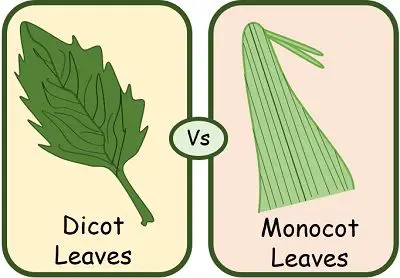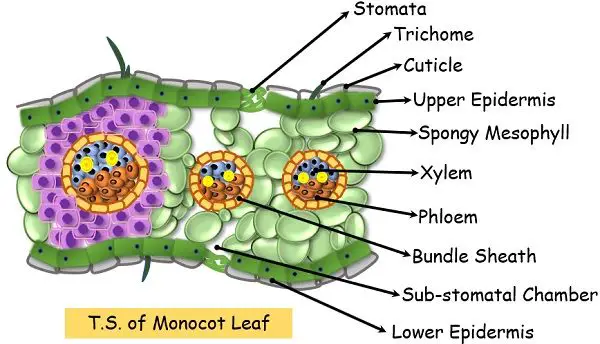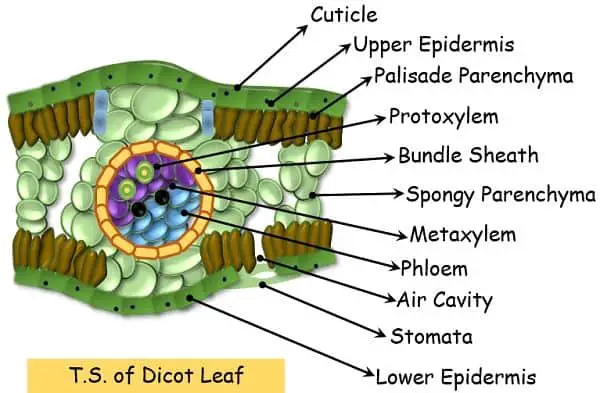We divide angiosperms into two main categories that are monocot and dicot. The leaf acts as a location where photosynthesis occurs for both of them. But both of their leaves vary immensely concerning the structure, characteristics and orientation.
The monocot leaf on one side is isobilateral in nature. Whereas the dicot leaves are dorsiventral. The monocot leaves are slender, thin and long with parallel venation. On the other hand, dicot leaves are broader and slightly thick with reticulate venation.
Both the upper and the lower surface of a monocot leaf is equally exposed to the sunlight. And thus, both the surfaces are identically green in colour.
In contrast, only the upper portion of a dicot leaf receives sunlight, and the lower doesn’t. Thus, the upper surface is of light green colour, and the lower is of darker green shade.
Here, you will learn the significant differences between the monocot and dicot leaves.
Content: Monocot Vs Dicot Leaves
Comparison Chart
| Basis of Comparison | Monocot Leaves | Dicot Leaves |
|---|---|---|
| Nature of Leaf | Iso-bilateral | Dorsoventral |
| Example | Wheat, maize, corn, rice, bamboo etc. | Legumes, tomato, oak, brinjal etc. |
| Stomata | Stomata are present on both sides, i.e., Amphistomatic | Only the lower surface of the leaf bear stomata, i.e., Hypostomatic |
| Motor Cells | Present in the upper epidermis | Completely absent |
| Mesophylls | Undifferentiated | Subtly differentiated as spongy and palisade parenchyma |
| Veins | Parallelly oriented | Irregular and scattered |
| Xylem Vessels | Each bundle has two protoxylems and two metaxylem | Numerous protoxylems and metaxylems are present in each bundle |
| Bundle sheath | More than a single layer | Only a single layer |
| Colour of Bundle sheath cells | Coloured due to plenty amount of chloroplast | Colourless |
| Bundle sheath extensions | These are comprised of sclerenchymatous cells | They are made up of collenchymatous cells |
| Venation Pattern | Parallel venation | Reticulate venation |
| Sides of Plant | Both the upper and the lower sides of the leaf are similar | In these leaves, upper and lower surfaces are different |
| Shape of Leaf | Mostly linear | They are of different shapes |
| Colour of Leaf | Equally green both upper and lower parts of a leaf | The upper surface of these leaves is a dark green, while the lower part is lighter shade of green |
| Leaf Blade | Thin, slender and flat | Broader leaf blade |
| Guard Cells | These are dumbbell-shaped cells in monocots | Here, the guard cells are kidney-shaped |
| Silica Deposition | Present | Absent |
| Vascular Bundles | Due to parallel venation, vascular bundles are of similar sizes | Vascular bundles are of different sizes due to reticulate venation |
| Orientation of vascular bundles | Randomly oriented | Present in rows |
| Bulliform Cells | Present, mainly in grasses | Absent |
| Intercellular Spaces | Fewer and smaller | Large and many |
| Exposure to Sunlight | Upper, as well as lower surfaces are equally illuminated by the sun. | The upper surface (adaxial) is exposed to the sun, while the lower (abaxial) doesn’t. |
| Kranz Anatomy | Present (In sugarcane, jowar and Maize) | Absent |
| Trichome | Present | Absent |
| Lateral walls | Straight | Sinuous/Curvy |
What is a Monocot Leaf?
Around 60,00 species of angiosperms are monocotyledon plants. We refer to them as monocots as they bear only one embryonic leaf, i.e., a single cotyledon. The leaves of the monocot plant are easily identifiable by their appearance. They are usually linear, long and slender with parallel venation.
Monocot leaves are directly attached to the stem without any petiole. They bear a very slender and flat lamina (leaf blade).
Structural Characteristics of Monocot Leaves
- Unlike dicots, the hypophyll region is dominant in the monocot leaves.
- Monocot leaf is referred as isobilateral or bicolateral as it is identical from both sides. For this reason, you cannot differentiate the leaf into its dorsal and ventral regions.
- The upper and the lower surfaces receive equal sun exposure.
- The number of chloroplasts on the upper and lower epidermis are the same. Due to this, the colour is identical green on both sides.
- The veins of monocot leaves have parallel venation.
- The veins arising from the base end travel together to meet at the leaf apex in these leaves.
- Here, only a single leaf arises per node. This is because the base of the leaf is broader enough to cover most of the circumference of a plant stem.
Anatomical Characteristics of Monocot Leaf
- Cuticle: The leaves of the monocot plants have a thick layering of cuticle on the upper epidermal surface. Whereas a very thin layering on the lower epidermis.
- Stomata: The monocot leaves are Amphistomatous as they possess the stomata on upper and lower surfaces. Thus, the sub-stomatal cavity lies on both sides.
- Motor cells: They are present in the upper epidermis.
- Mesophylls: These cells remain undifferentiated.
- Guard Cells: The guard cells at the stomatal opening are dumbbell-shaped.
- Bulliform Cells: These are empty colourless cells that play a role in folding and unfolding the leaf. In monocot leaves, these cells are largely found.
- Intracellular Spaces: There are significantly smaller spaces between the cells.
- Silica Deposition: Heavy silica deposition is present in these leaves.
- Vascular Bundles: Here, the vascular bundles have a parallel arrangement. And bundle sheath made up of parenchyma and sclerenchyma encircles them.
- Xylem Vessels: Each bundle presents two protoxylem and two metaxylem vessels.
What is a Dicot Leaf?
The dicots refer to those angiosperms that comprise two cotyledons. About 1,75,000 angiospermic species are dicots.
The leaves of dicotyledon plants are non-linear with a broad leaf blade or lamina.
Note: The cotyledons are embryonic leaves.
In dicots, two or more leaves can arise from one same node. These leaves are generally rounded that have reticulate venation.
Structural Characteristic of Dicot Leaves
- The leaves of the dicot plant can easily be differentiated into the dorsal and ventral parts because of the colouration. Thus, they are dorsoventral in nature.
- The upper or dorsal side has more pigmentation due to the presence of extra chloroplasts. This upper section receives plenty of sunlight, and it is dark (usually green) in colour.
- The lower or the ventral part is scarcely pigmented, with fewer chloroplasts. This lower section remains devoid of sunlight and is slightly lighter in the shade.
- The leaves of the dicot plant remain attached to the stem through the petiole. There might be small green appendages at the basal end of the petiole known as stipules.
- The leaf blade is the broadest part of a dicot leaf. It contains a fine network of branched veins that have a reticulate arrangement.
Anatomical Characteristics of a Dicot Leaf
- Cuticle: The cuticle is the outer waxy layer that envelops the epidermis of a leaf. This layer is equally thick in dicot leaves on both upper and lower epidermal surfaces.
- Stomata: The dicot leaves are hypostomatous in nature. This is because they bear only over the lower epidermis. Thus, the sub-stomatal cavities exist only on the lower section of a leaf.
- Guard cells: The guard cells at the stomatal opening are kidney-shaped.
- Silica Deposition: It is absent in these leaves.
- Intracellular spaces: There are large spaces between the adjacent cells. These spaces are frequently present throughout the leaf.
- Bulliform Cells: These cells are entirely absent in the dicot leaves.
- Mesophylls: The mesophylls are differentiated as palisade cells and spongy parenchymatous cells in dicots. These cells bearing ample chlorophyll are involved in the photosynthetic process.
- Vascular Bundles: The vascular bundles lie centrally in dicot leaves. Here, they are conjoint and closely packed. And are bordered by a layer of bundle sheath cells.
- Motor cells: These cells are absent in dicot leaves.
- Xylem vessels: Numerous protoxylem and metaxylem vessels are present in every bundle.
Key Differences Between Monocot and Dicot Leaf
- The monocot leaf is slender and elongated. Its hypophyll region, or the basal end of the leaf, is dominant. Whereas, in dicot leaves hyperphyll part is dominant, and they are broader in size.
- The shape of the monocot leaf is usually linear, but the dicot leaves have a variety of shapes.
- The dicot leaves are dorsoventral because the ventral and the dorsal portion are easily distinguishable. In contrast, the monocot leaves are isobilateral as you cannot differentiate the dorsal and ventral parts.
- The monocot leaves bear the stomata on both surfaces, i.e., it is Amphistomatous. In contrast, the dicot leaf is hypostomatous as it has the stomata only on the lower epidermis.
- The upper and lower regions of the monocot leaf are of the same colour. And the sun illuminates both surfaces equally. But the upper region is darker, and the lower region is lighter in dicot leaves. Here, the upper section receives more sunlight than the lower.
- The mesophyll cells of monocots are undifferentiated. But the mesophylls in dicots are differentiated into spongy parenchyma and palisade cells.
- The monocot leaves have parallel venation, but the dicot leaves have reticulate venation.
- The monocot leaves have unbranched veins, but dicot leaves have branched veins.
- The guard cells in monocots are dumbbell-shaped, whereas, in dicots, they are kidney-shaped.
- The vascular bundles in the monocot are arranged in proper rows, but in dicots, they are present randomly.
- The lateral walls of monocot leaves are straight, while dicot leaves are sinuous or curvy.
Summary
The monocots and dicots are the two types of flowering plants. Their leaves usually perform the same function, but they vary greatly in their structures and cellular orientation.
The monocot leaf is slender and long and has parallel venation. In comparison, the dicot leaves are broad and have reticulate venation. By this structural difference, one can easily identify whether the plant is monocot or dicot.




Leave a Reply